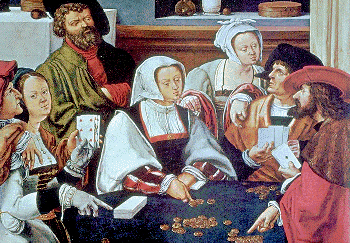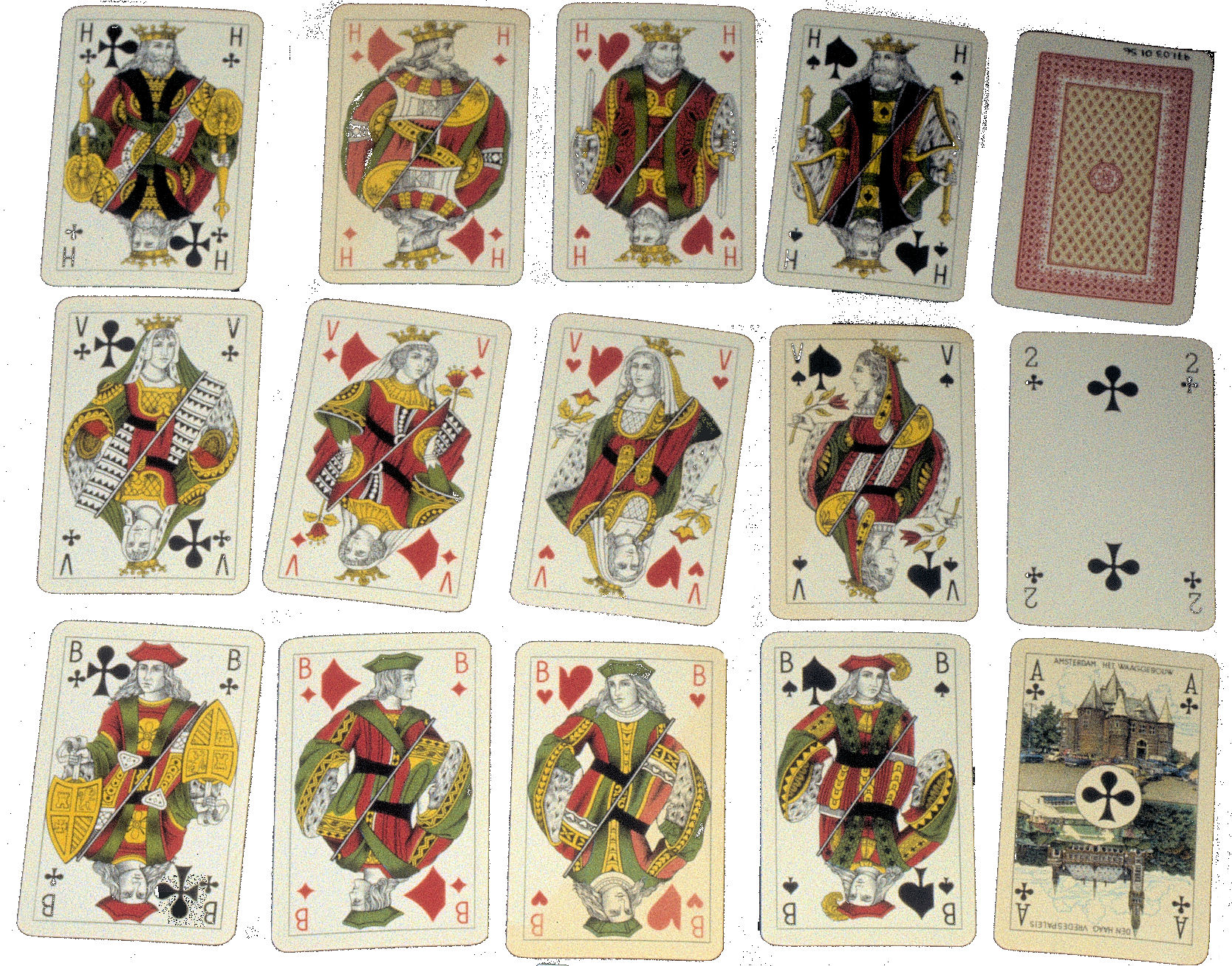 Card playing in The Netherlands may have been introduced from France. This notion is based upon the fact that the French suit indicators were used on cards seen in paintings from the Netherlands, as early as the 16th century. The detail from the Flemish painting at the left - The Card Players illustrates people holding cards with French suit indicators. Lucas van Leyden (Dutch 1494-1533) painted at least three different ones of people playing cards. The painting at the left is said to be "After Lucas van Leyden", (it was painted in his style by someone who perhaps was a student). The painting now hangs in the National Gallery of Art, Washington, D.C. Viewers of other pages in this section should observe that Italian and Spanish decks have different suit indicators - known as the Latin suits - composed of swords, cups, coins, and clubs. German and Swiss decks also have suits which are different from the French patterns. The French indicators are the ones found today on standard decks of playing cards in North America and many other parts of the world, i.e. - spades, hearts, diamonds, clubs.
Card playing in The Netherlands may have been introduced from France. This notion is based upon the fact that the French suit indicators were used on cards seen in paintings from the Netherlands, as early as the 16th century. The detail from the Flemish painting at the left - The Card Players illustrates people holding cards with French suit indicators. Lucas van Leyden (Dutch 1494-1533) painted at least three different ones of people playing cards. The painting at the left is said to be "After Lucas van Leyden", (it was painted in his style by someone who perhaps was a student). The painting now hangs in the National Gallery of Art, Washington, D.C. Viewers of other pages in this section should observe that Italian and Spanish decks have different suit indicators - known as the Latin suits - composed of swords, cups, coins, and clubs. German and Swiss decks also have suits which are different from the French patterns. The French indicators are the ones found today on standard decks of playing cards in North America and many other parts of the world, i.e. - spades, hearts, diamonds, clubs.
 The elaborate contemporary deck pictured at the right was puchased in 1972 in the Netherlands. It was manufactured in Belgium by Brepols for the Dutch market in the 1960s-1970s. The flap-top box (9.5cm long x 6.3cm wide x 1.9cm thick) has on one side a blue-back design which is on the back of each card in the deck. Printed in English on the box front are the words Superfine Royal Cards, with a blue peacock trademark design.
The elaborate contemporary deck pictured at the right was puchased in 1972 in the Netherlands. It was manufactured in Belgium by Brepols for the Dutch market in the 1960s-1970s. The flap-top box (9.5cm long x 6.3cm wide x 1.9cm thick) has on one side a blue-back design which is on the back of each card in the deck. Printed in English on the box front are the words Superfine Royal Cards, with a blue peacock trademark design.
Each of the 54 cards in the box are 9.2cm long x 6.1cm wide. There are 40 numbered cards - Ace through Ten, 12 face cards, and 2 Jokers. Suit symbols are of the French national suits. One of the Jokers is pictured in the upper right of the photograph. Below it is the Ace of Spades. The card pattern is a "standard" Dutch pattern.
Each Ace is double faced and has a different picture at each end and a center circle indicating its suit. For example: The Ace of Spades pictures the Sneek Waterpoort and the Rijksmuseum; The Ace of Hearts pictures Koninklijk Paleis in Amsterdam and the Stadhuis in Rotterdam.
Suit indicators and numbers appear in all four corners of the number cards. The face cards are double-head in the French style, however, the indicators are somewhat different than in France. In this deck, an "H(eer)" is used for a King, a "V(rouw)" is used for a Queen, and a "B(oer)" is used for a Knave - representative of the Dutch names for these card images.
 The contemporary deck also produced in Belguim (pictured on the left) was puchased in 1971 in the Netherlands, and is similar to the one above. This deck has the "standard" Blegian-Genoese pattern with Dutch indices and Dutch scenic Aces. It has been suggest that this type of deck was made for a Flemish market.
The contemporary deck also produced in Belguim (pictured on the left) was puchased in 1971 in the Netherlands, and is similar to the one above. This deck has the "standard" Blegian-Genoese pattern with Dutch indices and Dutch scenic Aces. It has been suggest that this type of deck was made for a Flemish market.
Each card is 8.8cm long by 6.7cm wide. There are 56 cards - 40 numbered cards - Ace through Ten, 12 face cards, 3 Jokers, and one score card for a game. An example of the card backs is illustrated in the photograph (upper right). The international suits are used in this deck, but the double-sided face cards carry the "H" for King, "V" for Queen, and "B" for Knave.
While the numbered cards have indicators and numbers in each of the four corners of the card, the Aces are double faced in this deck and have etchings of various well known building sites throughout cities of the world. For example: Paris, Venice, Washington, etc.
NOTE: This page was originally created and posted on the Web on February 12, 1998. Subsequently it has been modified and periodically updated. Last update: June 12, 2010